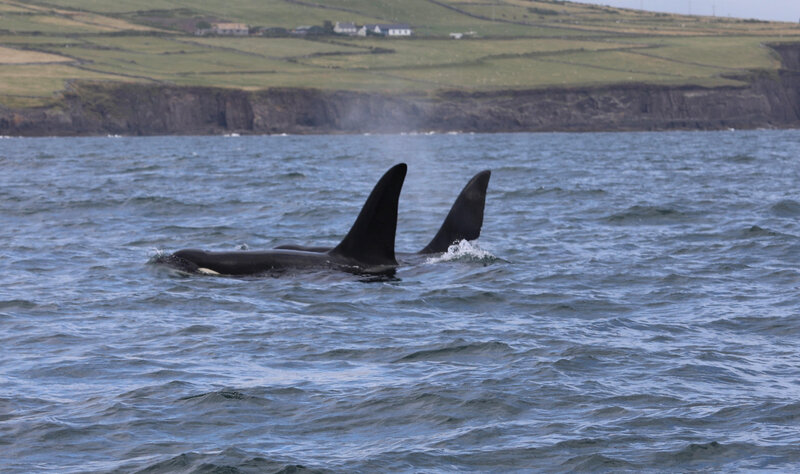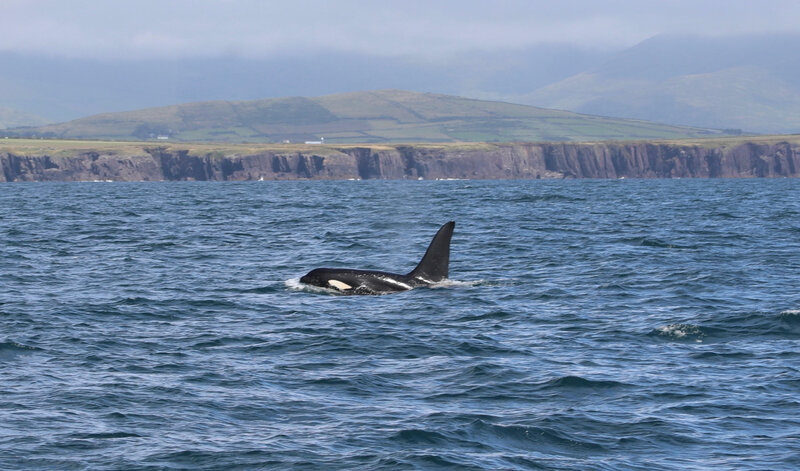Killer Whales "John Coe" and "Aquarius" revisit the Blaskets 10.07.2023
Killer Whales "Aquarius" and "John Coe" off Gleann Fán, Slea Head, Dingle Bay, 13:30 hrs. 10.07.2023
(photo taken on board M.V. "Blasket Princess" whale watching tour boat of Blasket Islands Eco Marine Tours by onboard passenger John Murdoch)

Killer Whale "Aquarius", Dingle Bay. 13:45 hrs. 10.07.2023
(photo taken onboard M.V. "Blasket Princess" whale watching tour boat of Blasket Islands Eco Marine Tours by onboard passenger John Murdoch)

Killer Whales John Coe and Aquarius in Blasket Sound, March 2018
Killer Whales "John Coe" and "Aquarius" revisit the Blaskets 10.07.2023
On Monday, July 10th. 2023 at 13:30 pm the well-known and well- catalogued male orca pair "John Coe" (approx. 63 yrs. old) and his younger male companion "Aquarius" (approx. 53 yrs. old) were spotted by the whale watching tour boat M.V. "Blasket Princess" about 2 miles south of Parkmore Point, Ventry harbour, Dingle Bay. For the rest of the 4 hr. Afternoon Dolphin and Whale Watching Tour they were seen multiple times as they headed west towards Slea Head and the Blasket Sound, and then towards Inish na Bró and Inishvickillaun - two of the outer Blasket islands. The author of this blog has seen them many times over the years and they are always a joy to behold!
Newsflash! Newsflash" 18.07.2023 A friend in Scotland [Jonathan Biddle, our wildlife guide via "Hebrides & NW Scotland Cetacean Sightings"] has just told me that both John Coe and Aquarius were spotted feeding in Loch Pootriel on the west coast of the Isle of Skye, west coast of Scotland at 19:00 hrs. on 18.07.2023, just one week after leaving the Blaskets!. We are glad that both John Coe and Aquarius arrived safely home, without any entanglement in fishing gear etc., after doing their annual Circuit of Ireland and look forward to seeing them again next year, probably in early July, which seems to be their favourite time of the year for their Circuit of Ireland.
They are the last two remaining (male) pair of the killer whale pod known as "The West Coast Community of Killer Whales" which originally was thought to number about 20 individuals in the 1970's and then down to 10 individuals (5 males and 5 females) when first catalogued and photo-identified in 1992 by the Hebridean Whale and Dolphin Trust. These individuals were given a catalogue number and name as follows: W001 John Coe (he was a full grown bull when first sighted in 1980); W002 Floppy Fin (male, last seen by us a few years ago in October off Minard, east of Dingle, and next day by some surfers in Brandon Bay with some other unidentified killer whales); W003 Nicola (who may be the mother of John Coe and the leader (matriarch) of the pack and with whom John Coe used to travel and do the Circuit of Ireland); W004 Moon (male, stranded on Lewis in 2008 and was found to have Minke whale baleen in his stomach contents); W005 Comet (male, nicknamed "Dopey Dick" - as opposed to "Moby Dick" - by the people of Derry when he swam up the river Foyle for 2 days chasing salmon in 1977 as a full grown (20 yrs.) old bull. He is estimated to have lived for up to 60yrs.); W006 Lulu (30 yrs old female who was found dead-stranded on a Hebridean beach on Tiree and when forensically necropsied was found to contain within her body a record toxic load (100 times above safe levels!) of highly poisonous contaminants including PCB's (Polychlorinated biphenyls), affecting immunity and fertility, and perhaps giving a clue as to the reason for the failure of the pod to produce any known calves or juveniles over the survey period since 1980); W007 Moneypenny (female, but I suppose if she had been a male, W007 would probably have been called "Bond: James Bond"); W008 Aquarius ( last remaining male companion to John Coe); W009 Puffin (female, first identified and named Puffin by the HWDT in 2000); W010 Occasus (female and the last of the community identified and given the number W010 by the HWDT in 2005 and fittingly named "Occasus" - meaning the setting (of the sun in the west) or sunset - by public competition run by the BBC in 2011 ).
Male orcas live on average 30 to 60 yrs. max. and female orcas live on average 46 to 90 yrs., although one famous female killer whale on the Pacific North West coast of America nicknamed "Granny" lived to a reputed 105 yrs.
The last two Killer Whales of their ecotype [in the Northern Hemisphere] and the two loneliest Killer Whales in the world!
To this day, and despite various studies, mystery surrounds the origins and ecotype of this group of Killer whales which we have previously written about in detail on March 9th, 2019 in a former blog on this website www.marinetours.ie entitled - Killer Whale "John Coe": The Loneliest Killer Whale in the World. www.marinetours.ie/wildlife-log.html
Way back, from the time that there were estimated to be about twenty killer whales in this pod, it was noted that they did not interact with the various other pods of killer whales off the Hebrides, Shetland islands, Orkney islands and Iceland. Killer whale pods consist of a family matriarchal group led by the oldest female and her sons and daughters and the family of her daughters. Various pods interact socially, including breeding, with other similar pods to form "clans" and various clans then represent the local population. In the NE Atlantic there are two main Killer whale ecotypes.
North Atlantic Type 1 are the more common ecotype and are mainly a fish-eating ecotype (herring and mackerel) with perhaps an occasional diet of young marine mammals. They are smaller than type 2 and have broader, blunter teeth than Type 2 - for chomping fish rather than killing and biting other marine mammal prey.
North Atlantic Type 2 is the ecotype that John Coe and Aquarius belong to and were originally a mammal-eating ecotype, distinguished by taller dorsal fin; larger body and about one meter longer that Type 1; with distinctive backward sloping eyepatch and sharper, bigger teeth - all the better for chewing through marine mammal bones of their prey of seals, porpoises, dolphins and whales (especially Minke whales).
Interestingly, since numbers have been decimated to two remaining in the pod, John Coe and Aquarius have never been seen hunting for marine mammals, and perhaps due to their decimated numbers they are no longer able to hunt marine mammals successfully as a co-ordinated pack and may have changed their diet? On no occasion, of the many times that we have seen them pass the Blasket islands with its large, resident population of grey seals and seal pups (in September / October) have we ever seen them preying on the seal population there.
But DNA analysis carried out from the necropsy of lulu who dead-stranded on a beach in Tiree in 2018 may hold a clue to what is happening and the tragic trajectory of this once proud and adventurous family of killer whales. Lulu was a female of about 30 years when she became entangled in fishing gear and basically starved to death and drowned as she was unable to swim due to the entanglement. Although a female of 30 years, analysis showed that she had never been pregnant and that she was closely inbred. It appears that the closest DNA profile to this pod of Type 2 killer whales lies in the Southern hemisphere in the Antarctic with the Type A Killer whales there who mainly prey on marine mammals and in particular Minke whales.
From this evidence it may be possible to conclude that this pod of killer whales - the Scottish West Coast Community of Killer Whales - originally made their way north to the Hebrides from the Southern Hemisphere and the Antarctic, and then gradually, as their number decreased from over twenty animals in the 1970's to ten animals (five male and five female) in 1992 and they could not encounter any of their own ecotype or other members of a similar clan for socialising and breeding, that the only other outlet was inbreeding, as was evident in the DNA analysis on the Lulu necropsy.
To us humans, all killer whales look vaguely the same - without scientific analysis or specialise expertise - but there is evidence from other parts of the
world, including the NE Pacific coast of America and Antarctica* that the various ecotypes of killer whales in different regions are exploiting different niches in the marine ecosystem, adapting and evolving different characteristics and morphological nuances. They are no longer breeding with other different killer whale ecotypes and when the different groups meet they studiously ignore each other and pass each other by, like ships in the night.
This appears to be the case with the last remaining members of the Scottish West Coast Community of Killer Whales, who are effectively on the road to extinction as a family group in the Northern Hemisphere.
Are "John Coe" and "Aquarius" searching for their lost family?
All of which brings us to the "Grand Tour of Ireland and the Irish Sea", or the "Circuit of Ireland" which John Coe and Aquarius do annually (much to our delight!) and formerly did in company with their pal "Floppy Fin" and before that John Coe liked to do the Circuit of Ireland with his mother "Nicola".
But, why?
As we mentioned above, in our many sightings of the various combinations of these animals over the years, we have never personally seen, or heard from anyone else, of any evidence of them hunting for marine mammals en route, whether for seals, dolphins, porpoises or Minke whales - all of which are plentiful in summer time around the Blasket Islands and Dingle Bay. There must be another reason why they undertake this journey annually.
We know that killer whales are sentient beings. they are rightly classified as oceanic dolphins and in the Delphinidae family, like Pilot whales, and derived the name "killer whales" from a misinterpretation of the words formerly used by ancient sailors to describe them - "ballena asesina" - meaning "Killer of (other) whales", shortened, over time, to Killer whales
But they have the largest brain mass of any marine mammal apart from the massive sperm whale and they also have an E.Q. [Encephalization quotient which is the ratio of brain mass to animal body weight] of 2.5 above average which is approximately the same as that of a chimpanzee - our cousins! Humans have an E.Q. of approximately 7. Killer whales also have a different and very complex fold system surrounding the brain which essentially means that you cannot compare like with like in terms of E.Q. alone.
In other words, Killer whales are smart, and they also appear to have emotional and social intelligence.
Is it a case that like elephants, who have an E.Q of 2.4, they also have long memories that perhaps make them happy and / or sad (?) and that one of the reasons for John Coe's and Aquarius's annual Circuit of Ireland or Grand Tour, previously undertaken in company with Floppy Fin and before that in the company of the matriarch of the pod "Nicola", is that they are looking for similar members of their own ecotype or the lost members of their own group? This is the reason why I said in my blog of March 9th, 2019 that John Coe may be the loneliest Killer whale in the world as he makes an annual search, with his last male friend Aquarius, for another of his kind.
But if the above hypothesis of original Antarctic origins is true - and since I wrote the article in March, 2019 some scientific papers have come out supporting this - then John Coe's and Aquarius's own ecotype kind are far, far away in the Southern Hemisphere and highly unlikely to retrace the doomed steps of this adventurous pod of killer whales that ventured (too) far north where no Southern Hemisphere Type A Killer whales had ever ventured before........................................................
Log of the Whale Watching Tour Boat M.V. "Blasket Princess"
Michael [Mick] Sheeran 10.07.2023
* In Scotland there are 3 different ecotypes: Type 1 - The Northern Isles Community - located around Shetland, Orkney, Northern Scotland and Iceland whose main diet appears to be ducks, seals, mackerel and herring and have worn broad teeth.
Type 2 - The West Coast Community - whose diet appears to consist of marine mammals, particularly Minke whales and harbour porpoises. John Coe and Aquarius are the last remaining members of this community
Type 3 - The Offshore "Viking" Community - based around Shetland and Norway. This free ranging ecotype was first identified as a separate ecotype in 2018
Coincidentally, in the Pacific North East, three separate ecotypes have also been identified;
Resident Community of Killer whales, who are fish eaters and whose diet consists mainly of salmon, halibut, mackerel and cod.
The Transient Community of Killer whales, who are marine mammal eating and whose diet consists mainly of harbour seals, Minke whales and grey whale calves. Their range is from Southern California to the Arctic Circle (also the range of halibut - as the author was once offered a job in Sausalito, California fishing for halibut from the Mexican border to the Canadian border).
The Offshore Community of Killer whales whose diet is mainly fish and shark and who travel in large pods of up to 50 individuals
In the richer hunting grounds of the Southern Hemisphere and the Antarctic there are up to 5 different ecotypes of Killer whales:
Type A - 9.5m long (31 ft.) which follows the migratory path of the Minke whale. This is the ecotype with the closest DNA markers to the DNA of the Scottish West Coast Community of Killer whales, including John Coe and Aquarius.
Type B (large) - pack ice seal-eating orcas as shown in Blue Planet (David Attenborough) with wave-making method of hunting to displace loitering seals from suitably inclined ice floes.[One thinks of Archimedes lying in his bath and coming up with the laws of flotation, and the rule that "an object displaces its own volume of water" or more accurately "The weight of the liquid displaced by the immersed part of a body is equal to the weight of the body" and one can see similarities between both species way of thinking!].
Type B (small) - penguin-eating Killer whales!
Type C - 6m long (20 ft) with mainly a diet of Antarctic toothfish
Type D - a distinctive ecotype with short dorsal fin, rounded head and small eye patch with mainly a diet of Patagonian toothfish.
What a wonderful and varied amount of different Killer whale ecotypes! It is only a matter of time before one of them comes up with another "Eureka!" moment.
Acknowledgements:
Hebridean Whale and Dolphin Trust
WDC [Whale & Dolphin Conservation] - "Meet the Different Types of Orcas"

























